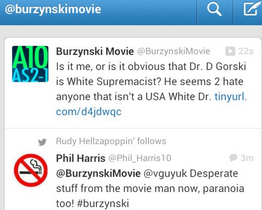DO YOU THINK YOU HAVE AN OPEN MIND? DO YOU HAVE THE ALL THE FACTS?
Basic claims about ANP
Antineoplastons are chemotherapy, regardless of what supporters say. Toxicity, reactions, and even patient deaths can and do happen due to their administration.
The most common side effect of ANP, hypernatremia, is an effect of the sodium in the mixture. In order to maintain their doses of ANP, patients are required to drink obscene amounts of water every day (some report up to 12 quarts or more). If they fail to do so, they may lapse into unconsciousness or die. There are two cases of children (Haley S. and Elizabeth K.) at The OTHER Burzynski Patient Group who have had strokes unrelated to their tumors, likely because of the treatment.
For an example of a patient nearly overdosing, see Adam M’s story. Patients seem to often end up in the hospital because of the treatment.
Did Stanislaw Burzynski invent gene-targeted therapy?
Can the FDA clinical trial system accommodate personalized treatments?
The movie claims that the current paradigm of clinical trials can’t accommodate personalized therapy, however, cancer centers have been and are doing this research. Director Eric Merola simply seems to be unaware of this. Such trials are currently being conducted right down the road from the Burzynski Clinic at M.D. Anderson in Houston: http://bit.ly/m0cO1w.
A surgical oncologist, researcher and patient advocate explains why physicians question Dr. Burzynski’s methods:
- http://www.sciencebasedmedicine.org/index.php/stanislaw-burzynski-bad-medicine-a-bad-movie/
- http://www.sciencebasedmedicine.org/index.php/stanislaw-burzynskis-personalized-gene-targeted-cancer-therapy/
- http://www.sciencebasedmedicine.org/index.php/stanislaw-burzynski-antineoplastons-and-the-orphan-drug-sodium-phenyl-butyrate/
- http://www.sciencebasedmedicine.org/index.php/stanislaw-burzynskis-cancer-success-stories/
This physician and others declined to be interviewed for the movie because of Merola’s track record of slanted presentation and because of past threats issued by people hired by the Burzynski Clinic.
What was the “present” from skeptics that was alluded to in the movie?
The “present” the Skeptics for the Protection of Cancer Patients (SPCP) delivered to Burzynski on his birthday, was a donation of $14,500 to St Jude Children’s Hospital for research into childhood cancers. They challenged Dr. Burzynski to match their donation. He did not. In fact, some of the interviews in the movie (conducted after the FDA inspection of the Burzynski Clinic, mentioned at the end) were filmed after the fundraiser had been announced, so Merola seems to have deliberately omitted the whole truth, because he certainly was aware of it.
Doesn’t sound so sinister now, does it?
Also, Burzynski got a birthday card.
Merola shamelessly distorts evidence. Don’t believe it?
The video of the “leaked skeptic conference call” shown in the film was actually constructed from excerpts from episode 13 of the Virtual Skeptics, a weekly panel show broadcast on the web. The skeptic who called Dr. Burzynski “my little Polish sausage” has a Polish last name, which the director Eric Merola scrubbed from the movie. Literally one second after he said that, all of the other participants made jokes about that fact (which of course was the point).
Instead allowing the audience to hear that ribbing, Merola inserted an evil laugh, which was lifted and spliced from minute 18:25 of Virtual Skeptics episode 13. Voices were altered to sound sinister, and menacing music was added. By the way, that same skeptic’s employer was contacted by Merola for comment. The skeptic, however, wasn’t. (Read the letter!)
Do you think this is a fair representation or were you misled?
Are skeptics really calling out cancer patients, ridiculing and harassing them?
Merola suggests that patients are being ridiculed and harassed on the Internet, especially at what he calls a “death list” website. In fact, at The OTHER Burzynski Patient Group, patients are identified by the standard convention of case histories, a first name and last initial, so that it is impossible for anyone who looked for a patient’s name in Google would come across the site. Links are provided to sources that patients themselves have put online, and visitors are encouraged to follow those links and read the patients’ heartbreaking stories in their own words. Check the website for yourself and you’ll see there is no harassment there.
What about the 2-hour rejection from The Lancet?
High impact journals like The Lancet receive huge numbers of submissions, as their journal is the most prestigious. The vast majority of papers that get rejected by The Lancet are rejected within 48 hours thanks to an editorial pre-screening process that helps accommodate this huge work load. Most researchers are thankful for this courtesy because it allows them to resubmit to other journals more quickly. Why does Merola try to convince the audience that this is evidence of a conspiracy against Burzynski?
Does Eric Merola have any conflicts of interest that he is not disclosing?
Eric Merola does not reveal a possible conflict of interest, one that a journalist would feel obliged to share. He fails to disclose in the movie that his cousin was a patient of Dr. Burzynski and that he has raised money on his movie’s website for patients to see Burzynski. Read her story.
Patients pay a lot of money upfront to enter his clinical trials, presumably believing that the trials will eventually be published. Burzynski has never published the results of those trials but keeps the money:
Burzynski’s abysmal trial completion record, over sixty abandoned trials, the trust of every patient who participated betrayed. If trial completion were a batting average, he’d be batting .016. His publication average is .000. Really:
http://clinicaltrials.gov/ct2/results?term=burzynski&pg=1
For a comparison to other clinical trial completion rates, see this short video.
Speaking of harassment…
Merola does not mention that skeptics only caught wind of the Burzynski story in November 2011, after a teenaged blogger critical of the Clinic received phony legal threats from someone who had been hired by the Clinic to “clean up” its reputation. This person, Marc Stephens, sent this high school student images of his family’s home, the message clearly: “We know where you live.” These threats were well documented in the international press. Somehow Merola managed to not mention that in the movie.
The Clinic’s representatives have threatened his former cancer patients at home
Former Burzynski cancer patient Wayne Merrit and his wife, a breast cancer survivor, were threatened with legal action in writing and on the phone by the same contractor to the Burzynski Clinic after they were critical of him online. Read the Merritts’ story and see the threats here.
What about the young mother, Laura Hymas, who was “completely cured” of brain cancer?
What really happened to Amelia Saunders?
Merola suggests that Amelia Saunders died as a result of her parents taking her off of antineoplaston therapy, that there “confusion and disagreement” between the doctors in the UK and Houston’s reading. There was no confusion–Burzynski was wrong. When her father described the tumor online as “breaking up on the inside,” competent oncologists on the web recognized this as a sign that the tumor had outgrown its blood supply. This was confirmed when the Saunders’ took Amelia for a second opinion. There is no confusion: the Burzynski Clinic was WRONG.
Burzynski has a long history of patients believing that symptoms of getting worse are signs they are getting better. Follow any of the links at that site to hear how, in patients’ own words, this EXACT SAME misleading interpretation has been fed to patients for decades.
Merola has publicly slandered Burzynski critics in a way a real journalist couldn’t
Take for instance, his comments about a prominent Burzynski critic who started his online skeptical career taking on Holocaust deniers:
We hope this makes it clear that what you are seeing in the new Burzynski movie may not be entirely reliable.
As we get more information about the claims in the movie, we will add additional rebuttals and provide context for understanding what really goes on at the Burzynski Clinic.




Pingback: Science-Based Medicine » Eric Merola’s conspiracy-mongering and Dr. Stanislaw Burzynski’s cancer “success” stories, part 2
Pingback: Burzynski blogs: My Master List | Josephine Jones
I was diagnosed with Glioblastoma Multiforme 12/31/2012. I
ve been through the standard of care, surgery, radiation, and chemo (temodar). I came through the rt & chemo with virtually no side affects other than fatigue, and by all accounts, I’m doing pretty well now.
I fully expect to have a recurrence at some point, and I’ll deal with that then. What I won’t do, no matter what, is go to the Houston Quack. I don’t believe that he can cure a hangnail, much less brain cancer. I certainly don’t want to die from this, and I’ll do everything possible to stave off that possibility (other than the foregoing), But if that is my destiny, at least I’ll go with my finances (and my kids & future grandchild’s inheritance intact. My misfortune is not going to enrich that unethical, dishonest bastard.
ML, I’m truly thankful for your story. Thanks for speaking up about the ongoing catastrophe in Houston. Speaking up will save lives, I’m certain of it.
ML,
I too would like to thank you for speaking out. I wish more people would. IMO you have done everything right for yourself. You have made rational, effective decisions regarding your choice of treatment. Then there are the people who when face with these difficult decisions let emotions rule the day. They will be the one’s who become vulnerable to the Burzynski’s of the world.
I hope you continue to do well and are one of the one’s who beats the odds.
Best Regards
SusanG
Pingback: Refael Elisha Cohen: A Family’s Misery Exploited | Skeptical Humanities